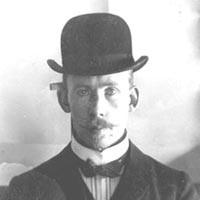
1873 - 1910
Johan Alfred Andersson Ander
Summary
Name:
Johan Alfred Andersson AnderYears Active:
1910Birth:
November 27, 1873Status:
ExecutedClass:
MurdererVictims:
1Method:
BludgeoningDeath:
November 23, 1910Nationality:
Sweden
1873 - 1910
Johan Alfred Andersson Ander
Summary: Murderer
Name:
Johan Alfred Andersson AnderStatus:
ExecutedVictims:
1Method:
BludgeoningNationality:
SwedenBirth:
November 27, 1873Death:
November 23, 1910Years Active:
1910bio
Johan Alfred Andersson Ander was born on 27 November 1873 in Ljusterö, Sweden. During his early adult life, he completed military service between 1893 and 1894, serving with the Vaxholm Artillery Corps. After finishing his service, Ander married and tried to establish a livelihood as a waiter and hotel owner. Unfortunately, his business ventures repeatedly failed—first in Strängnäs in 1898 and later in Helsinki in 1903.
Reports from the time suggested that excessive drinking and mistreatment of his wife contributed to his repeated financial and personal difficulties. Andersson Ander had a criminal record prior to his final conviction. In 1900, he was jailed for theft-related offenses and even managed to escape custody at one point. Over the years, Ander accumulated three separate convictions for theft (“tredje resan stöld”), marking him as a repeat offender in Swedish courts.
By 1909, he had moved back into his parents’ home in Karlsudd with his wife, struggling with poverty and social disgrace.
murder story
In late 1909 and early 1910, Johan Alfred Andersson Ander was observed repeatedly visiting and watching Gerells Växelkontor, an exchange agency located at Malmtorgsgatan 3 in Stockholm. Ander was reportedly facing severe financial hardship and sought to solve his money problems through theft.
On 5 January 1910, Ander carried out a violent robbery at the agency. Armed with a steelyard balance, he attacked clerk Victoria Hellsten, beating her so severely that she later died from her injuries. Ander fled the scene with approximately 6,000 Swedish kronor in cash and foreign banknotes—an amount equivalent to nearly 200,000 SEK in modern value.
Following the murder, Ander checked into a nearby hotel named Temperance. Staff noticed his anxious demeanor and later reported seeing him leave with a suspiciously shaped oblong package. When police searched Ander’s hotel room, they found incriminating evidence, including Hellsten’s wallet and a large portion of the stolen money stained with blood.
Authorities tracked Ander down through ferry workers in the archipelago who recognized his movements. He was arrested at night at his father’s house near Vaxholm. The package found during his arrest contained the murder weapon.
During his trial, Ander denied committing the murder, claiming instead that he had received the money from an unknown foreign man. Despite this defense, the evidence against him was overwhelming. Swedish courts at all levels sentenced him to death. Although his father petitioned for clemency, King Gustaf V denied the appeal.
On 23 November 1910, Ander was executed at Långholmen Prison in Stockholm by guillotine. This marked the first and only time Sweden used a guillotine for capital punishment. Prior to this, executions had been carried out by manual beheading, and Sweden would abolish the death penalty completely in 1921.
Ander greeted the execution team with a calm “Good morning, gentlemen!” and attempted to say final words, which were denied by the executioner. Without resistance, Ander lay on the guillotine, and moments later, he was beheaded. His body was donated to science, where doctors discovered he had tuberculosis and found porcelain fragments in his stomach, suggesting a possible suicide attempt while in prison.
This execution not only ended Ander’s life but also marked the final chapter of Sweden’s use of capital punishment, as no further executions were carried out in the country after his death.